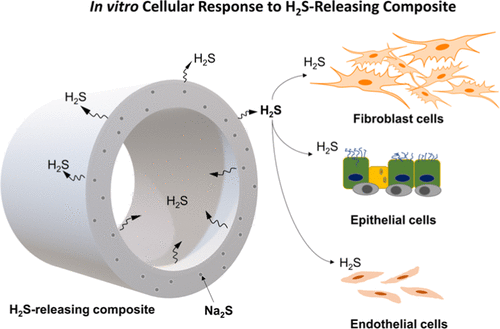当前位置:
X-MOL 学术
›
ACS Biomater. Sci. Eng.
›
论文详情
Our official English website, www.x-mol.net, welcomes your
feedback! (Note: you will need to create a separate account there.)
H2S-Releasing Composite: a Gasotransmitter Platform for Potential Biomedical Applications
ACS Biomaterials Science & Engineering ( IF 5.4 ) Pub Date : 2020-03-13 , DOI: 10.1021/acsbiomaterials.0c00146 Jitendra Pant 1 , Arnab Mondal 1 , James Manuel 1 , Priyadarshini Singha 1 , Juhi Mancha 1 , Hitesh Handa 1
ACS Biomaterials Science & Engineering ( IF 5.4 ) Pub Date : 2020-03-13 , DOI: 10.1021/acsbiomaterials.0c00146 Jitendra Pant 1 , Arnab Mondal 1 , James Manuel 1 , Priyadarshini Singha 1 , Juhi Mancha 1 , Hitesh Handa 1
Affiliation

|
Hydrogen sulfide (H2S) is an endogenous gasotransmitter in the human body involved in various physiological functions including cytoprotection, maintaining homeostasis, and regulation of organ development. Therefore, H2S-releasing polymers that can imitate endogenous H2S release can offer great therapeutic potential. Despite decades of research, the use of H2S donors in medical device applications is mostly unexplored largely due to the challenge of the steady H2S release from a suitable polymeric platform that does not compromise the normal cellular functions of the host. In this work, an exogenous H2S release system was developed by integrating sodium sulfide (Na2S), a common H2S donor, into a medical-grade thermoplastic silicone-polycarbonate-urethane polymer, Carbosil 20 80A (hereon as Carbosil), via a facile solvent evaporation technique. The spatial distribution and nature of Na2S in Carbosil were characterized through X-ray diffraction (XRD) spectroscopy and field emission scanning electron microscopy (FESEM) with energy-dispersive spectroscopy (EDS), indicating an amorphous phase shift upon incorporating Na2S in Carbosil. The composite, Na2S–Carbosil, is responsive in physiological conditions, resulting in sustained H2S release measured for 3 h. In vitro cellular responses of 3T3 mouse fibroblasts, human lung epithelial (HLE), and primary human umbilical vein endothelial cells (HUVEC) were investigated. Fibroblast cells showed cell proliferation in 24 h and complete cell migration in 42 h in vitro. The Na2S–Carbosil composites were cytocompatible toward HUVEC and HLE cells. This study provided important in vitro proof of concept that warrants potential use of these H2S-releasing platforms in engineering biomedical devices, tissue engineering, and drug delivery applications.
中文翻译:

H 2 S释放复合材料:潜在生物医学应用的气体传输平台
硫化氢(H 2 S)是人体内的一种内源性气体递质,参与多种生理功能,包括细胞保护,维持体内稳态和调节器官发育。因此,可模仿内源性H 2 S释放的H 2 S释放聚合物可提供巨大的治疗潜力。尽管进行了数十年的研究,但由于在不损害宿主正常细胞功能的情况下,从合适的聚合物平台中稳定释放H 2 S的挑战,在医疗设备应用中H 2 S供体的使用仍未得到开发。在这项工作中,外源ħ 2的Release系统是由积分硫醚钠(Na开发2S),一种常见的H 2 S供体,通过一种简便的溶剂蒸发技术,被制成医用级热塑性有机硅-聚碳酸酯-氨基甲酸酯聚合物Carbosil 20 80A(以下简称Carbosil)。通过X射线衍射(XRD)光谱和带能量色散光谱(EDS)的场发射扫描电子显微镜(FESEM)表征了碳中Na 2 S的空间分布和性质,表明掺入Na 2 S时出现无定形相移在Carbosil。复合物Na 2 S-碳纳米管在生理条件下有反应,导致持续3 h的H 2 S持续释放。体外研究了3T3小鼠成纤维细胞,人肺上皮细胞(HLE)和人原发性脐静脉内皮细胞(HUVEC)的细胞应答。成纤维细胞显示出细胞增殖在24小时和在42小时内完成细胞迁移的体外。Na 2 S–Carbosil复合材料对HUVEC和HLE细胞具有细胞相容性。这项研究提供了重要的体外概念证明,可保证在工程生物医学设备,组织工程和药物输送应用中潜在使用这些H 2 S释放平台。
更新日期:2020-04-23
中文翻译:

H 2 S释放复合材料:潜在生物医学应用的气体传输平台
硫化氢(H 2 S)是人体内的一种内源性气体递质,参与多种生理功能,包括细胞保护,维持体内稳态和调节器官发育。因此,可模仿内源性H 2 S释放的H 2 S释放聚合物可提供巨大的治疗潜力。尽管进行了数十年的研究,但由于在不损害宿主正常细胞功能的情况下,从合适的聚合物平台中稳定释放H 2 S的挑战,在医疗设备应用中H 2 S供体的使用仍未得到开发。在这项工作中,外源ħ 2的Release系统是由积分硫醚钠(Na开发2S),一种常见的H 2 S供体,通过一种简便的溶剂蒸发技术,被制成医用级热塑性有机硅-聚碳酸酯-氨基甲酸酯聚合物Carbosil 20 80A(以下简称Carbosil)。通过X射线衍射(XRD)光谱和带能量色散光谱(EDS)的场发射扫描电子显微镜(FESEM)表征了碳中Na 2 S的空间分布和性质,表明掺入Na 2 S时出现无定形相移在Carbosil。复合物Na 2 S-碳纳米管在生理条件下有反应,导致持续3 h的H 2 S持续释放。体外研究了3T3小鼠成纤维细胞,人肺上皮细胞(HLE)和人原发性脐静脉内皮细胞(HUVEC)的细胞应答。成纤维细胞显示出细胞增殖在24小时和在42小时内完成细胞迁移的体外。Na 2 S–Carbosil复合材料对HUVEC和HLE细胞具有细胞相容性。这项研究提供了重要的体外概念证明,可保证在工程生物医学设备,组织工程和药物输送应用中潜在使用这些H 2 S释放平台。











































 京公网安备 11010802027423号
京公网安备 11010802027423号